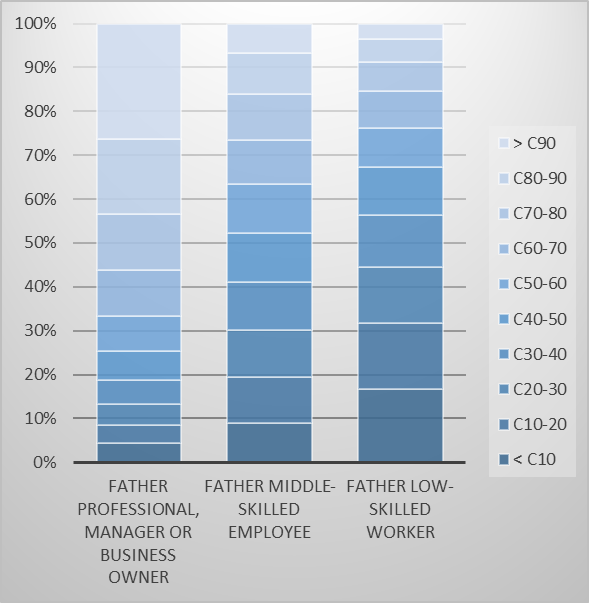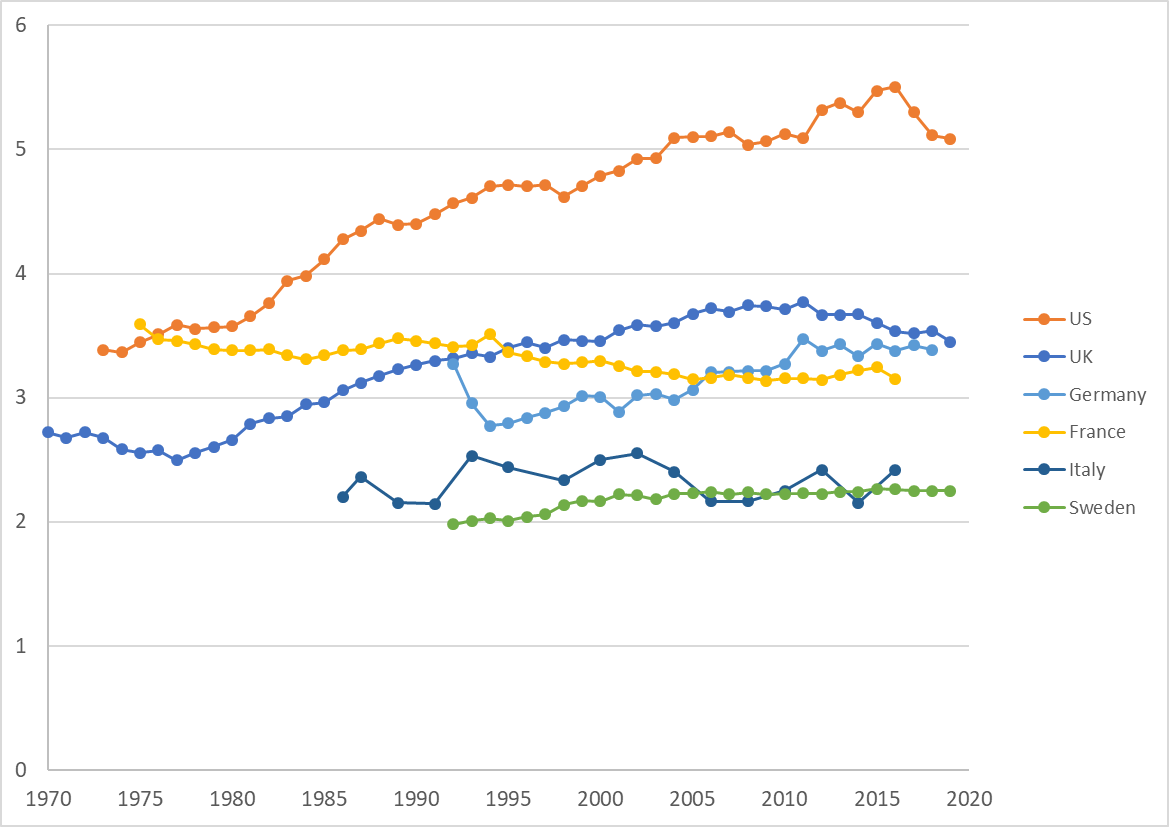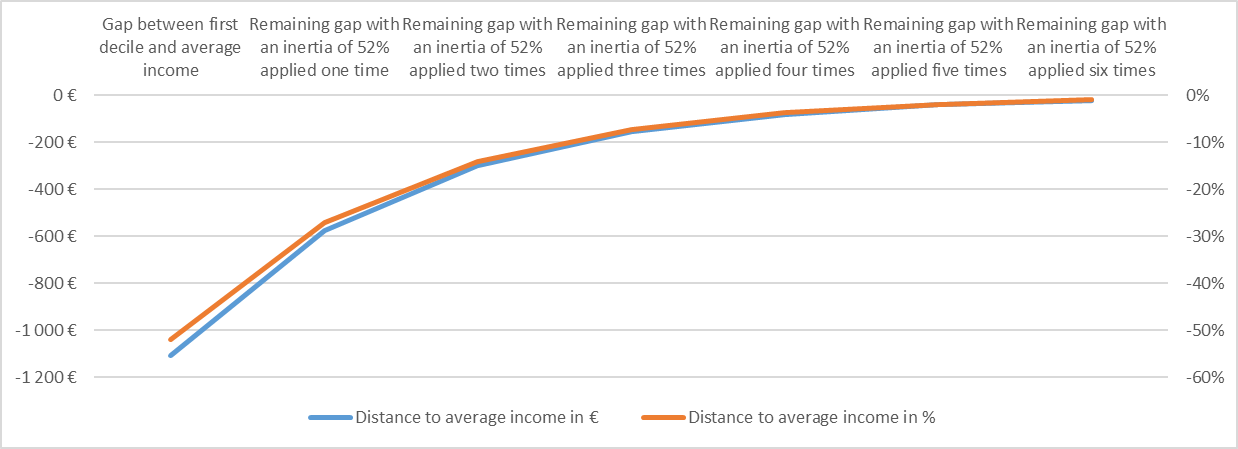
Still, the number of studies on this issue is growing rapidly, as attested by the publication in 2018 of the OECD's report «Is the Social Ladder broken? How can Social Mobility be promoted? » In this assessment, France scored badly. Does France, where inequality seems to be more under control than elsewhere, have a specific problem of low mobility from one generation to the next?
Box 1 – Intergenerational income mobility in France : main results
There is no consensus today about the relative position of France compared with other countries for intergenerational income mobility. In multiple studies, France appears to be a country with an 'intermediate' level of mobility (Lefranc and Trannoy, 2005), 'low' and lower than the United States (OECD, 2018) or 'high' and comparable to Sweden (Alesina et al. 2018). The heterogeneity of data in different countries, together with the fact that parental incomes are not directly observed in French surveys makes this comparison difficult. The OECD work concludes that France ranks among the low-mobility countries, with an income inertia [1] of fifty-two per cent across generations, compared with less than forty per cent for OECD countries. However, the same study shows that children from modest backgrounds in France are more likely to reach a high income level than in the United States and Germany. In addition, children whose parents have a high income are less likely to have a high income in France than in these two other countries. These results owing to the difficulties inherent in this comparative analysis, however, must be used with caution.
The data used to measure the evolution of mobility in France in the long run, focusing on intergenerational inertia, do not yield a clear consensus either. Lefranc and Trannoy (2005) illustrate the stability of inertia between 1977 and 1993 at approximately forty percent. Lefranc (2018), for his part, notes a V-shaped curve between the generations born in the 1930s (high inertia), the 1940s to 1960s (lower inertia,forty-five percent) and the 1970s. These results must be interpreted with caution, considering the limitations of the data on extreme cohorts. They reflect an evolution in income inequality more than changes in the relative probabilities of attaining a certain rank in the income distribution.
Intergenerational mobility: what criteria and how to measure it?
Here the key issue remains: the inequality of outcomes between children from advantaged and disadvantaged backgrounds. Despite the prevalence of this notion in public debates, social background does not 'determine' individual destiny. In fact, social background barely accounts for ten to twenty percent of income differences between persons of the same generation [2]. Indeed, upward or downward mobility is rather the rule; in this respect France does not differ from the average of other countries. According to the OECD (2018), if occupations are grouped into seven families based on the ESeC nomenclature [3], approximately two thirds of French people work in an activity different from that of their parents.
Using a different methodology based on the six social categories contained in the PCS nomenclature, Collet and Pénicaud (2019) show that in 2015, only one third of persons belong to the same category as their parents, while vertical occupational mobility - mostly upward - has increased substantially over the last forty years. There are both children of manual workers and children of managers at the top and bottom of the distribution of living standards (Dherbécourt, 2018). In other words, the heterogeneity of income among children of the same social background is very high (see Figure 1). Yet it is undeniable that the chances of access to high income and different social positions vary on average according to social background.
Figure 1 – Position of individuals in the distribution of living standards (in adulthood) within their generation

Reading: Four percent of people whose fathers are professionals, managers or business owners are, in adulthood, among the ten percent of their generation with lowest leaving standards (birth cohorts 1970-1984).
Source: Dherbécourt (2018)
Before addressing the conclusions contained in the literature, a methodological discussion is needed. The measurement of social mobility, and its relationship to social reproduction, are far from obvious.
The first step consists in choosing a measure of the situation or the position of persons within their generation, chiefly using individual income as a gauge. Two other criteria have also been studied in the literature : occupation and educational level—criteria here omitted as posing problems for comparison in time and space [4]. Moreover, other criteria such as wealth, health, skills, or well-being are examined in the literature, though data in these categories do not permit comparisons in space and time [5]. Income, therefore, emerges as the best, single criterion for assessing social mobility. Even if well-being is not restricted to income, it does afford some notion of social position, as do the level of goods and services to which people have access. This facilitates comparisons in space and time, even if it does not resolve all the problems inherent in this study.
Indeed, once income has been chosen as a criterion for determining social mobility, it remains to define what is meant by « social mobility. » At present, two different approaches to this question exist. According to the first, it is necessary to measure inequality of opportunity by income level through calculating the average inertia of income. Income inertia compares the average income difference between two randomly selected children to the average income differential of their parents. The closer this inertia is to 100%, the greater the impact of parental income on children income in average. The measure of average inertia depends, however, on both the correlation between parents' and children’s income and the level of income inequality in the country (Heckman, 2013; Lefranc, 2018). According to this approach, a country where income inequality increases across generations will have a higher intergenerational inertia, other things being equal (see box 2).
Box 2 – Average inertia: a measure sensitive to income inequality
Intergenerational inertia, called "intergenerational elasticity" in the literature (IGE), corresponds to the coefficient β of the following formula: Xe=α+β.Xp, where Xe and Xp correspond respectively to the logarithm of the incomes of the children and the parents.
The coefficient β can be decomposed as follows β = Image . corr(Xe,Xp) is the correlation coefficient between the log income of parents and children, also called IGC in the literature. This coefficient is insensitive to income heterogeneity. Image and Image correspond to the standard deviations of the lof of each generation’s income. Image/Image thus measures the level of relative inequality of the children's generation compared to that of the parents. A higher level of income inequality for the child generation mechanically raises the average level of inertia β, other things being equal.
From this point of view, the fact that wage inequality tends to decline in France over the long term, should theoretically act as a moderating force in the intergenerational inertia. In the thirty years between 1985 and 2015, the inter-decile ratio of men's wages fell by about ten percent (see figure 2)—a fact that should in theory reduce the inertia between fathers and sons. France represents a special case in this respect, since in most developed countries male wage inequality has stagnated as in Italy and Sweden, or increased as in Germany, the United States and the United Kingdom.
Figure 2 - Changes in the inter-decile ratio (D9/D1) of male wages in some western countries

Reading: in the United States, in 2015, the 9th decile of male hourly wages is 5.1 times higher than the first decile.
Source: ocde.stats and insee.com
The second approach to intergenerational mobility focuses only on the relationship between the rank of children and parents, without considering that these ranks may differ according to income level. This « rank » approach has the advantage of focusing on positional mobility, neutralising the effect of income inequality. It greatly facilitates comparison in space and time. It also to focus on children from modest, or privileged backgrounds, where the inertia approach gives a synthetic figure. Conversely, from one country to another, and from one period to another, the income gap between ranks can change considerably, which the positional approach does not take into account. Therefore, he two approaches are complementary.
To measure inequality of opportunity, it is therefore necessary to consider that this depends, to put it simply, on two criteria: positional mobility--the difficulty of reaching different ranks according to the parents' rank, and the inequality that affects the level of income associated with each rank.
Having established this distinction between mobility of position and inequality, this study offers the most updated information on the evolution of intergenerational income mobility, first in France, and then internationally.
Evolution of social mobility over time in France
Two articles analyse the evolution of income mobility in France using the measure of the average wage inertia. Lefranc and Trannoy (2005) estimated the evolution of intergenerational wage inertia over sixteen years between 1977 and 1993, using FQP surveys (see box 3). Child earnings are observed between the ages of thirty and forty. Father’s income is calculated from previous series of surveys taken from information declared by the children. Given the low rate of women’s participation in the labour force during the 1960s and 1970s, mother’s income is not listed in the study, which focuses rather on father-son and father-daughter pairs. This study concludes that there is no statistically significant trend over this period. The wage inertia between fathers and sons was forty-one percent in 1977, thirty-six percent in 1985, and forty-one percent in 1993 [6]. Wage inertia between fathers and daughters, which is lower, increases slightly for these years : twenty-three percent in 1977, twenty-nine percent in 1985 and thirty-two percent in 1993. The authors conclude that the decline in income inequality observed in the 1980s does not seem to have affected income inertia, implying that the correlation between parental and child income has increased.
Box 3 – Sources for the study of intergenerational mobility of revenues in France
All the work published to date on the issue of intergenerational income mobility in France is based on the INSEE FQP survey. This survey includes a great deal of data on the parents of people at the end of their studies including details of occupation, highest diploma obtained, and place of residence.
The advantage of this survey is that it includes a measure of income levels since 1964 (in brackets, then in value since 1970). By contrast, INSEE’s Enquête Emploi, also with data on parents, only includes information on wages since 1990.
FQP does not allow the parents' income level to be observed. However, by using several waves of the survey, it is possible to estimate the average income of fathers as reflected by the incomes of persons similar to them for certain criteria --occupation, level of education, number of children-- using the method known as the 'two-sample instrumental variables' method of Björklund and Jäntti (1997). This method makes it possible to estimate an average income by category, but does not take account the heterogeneity of income within categories.
This "instrumental" method has also been implemented by the OECD on the SRCV survey (2011 survey on social origin).
INSEE’s permanent demographic sample (EDP) is the only source that theoretically allows direct measurement of the income of parents and children several years apart, because of the matching between census, employers-employees data and tax data (FIDELI) for a sample of approximately 1% of the population ("EDP" individuals). Using census data since 1968 and tax data since 2010, it is possible to identify EDP parent/child pairs, and then observe their wages in DADS available since 1967 and their income in FIDELI. Until recently, however, the number of children reaching adulthood was insufficient to exploit EDP.
Lefranc (2018) used FQP survey data from 1964 to 2003 to study the evolution of average wage inertia for men born in the generations between 1933 and 1973. He finds that inertia evolved in a V-shaped pattern: sixty percent for the generation of the 1930s, forty-five percent for those of the 1940s and 1950s and fifty-five percent for those of the 1960s and 1970s. The results for the extreme cohorts must be treated with caution, considering the constraints imposed by the age of observation of parents, something that may upwardly bias in the results [7]. The change over time is chiefly related to changes in wage inequality, and very little to changes in positional mobility. The decline in the inertia of the generations of the 1940s and 1950s is linked to the sharp decline in the level of income inequality of these generations.
No other information exists for France. The literature emphasises the stability of positional mobility over the long term (Chetty et al., 2014a).
Social mobility in international comparison
Several publications propose an international comparison of income mobility between fathers and sons, either from inertia or from the link between income ranks. The results do not produce a clear consensus, something that might be explained by methodological problems. As already noted, the French data used in the literature only allow the income of fathers to be derived on the basis of the characteristics declared by their children. The same holds true for a large number of countries, with the notable exception of Germany, the United States, and the Scandinavian countries. However, the quality of the data and the choice of variables used for calculation renders the results uncertain.
The first article by Lefranc and Trannoy (2005) places France in a median situation with a forty percent inertia, between the United States (inertia of fifty-two percent) and Sweden (twenty-eight percent). Lefranc (2018) finds a comparable figure for France, for the median birth cohorts in his sample, but a higher figure for the others (fifty-two per cent for the most recent cohorts). This calls for caution on the results that can be drawn from FQP.
The above OECD report draws on many sources to make a comparison between twenty-six developed countries, using data on sons as adults in the late 2000s. Data for France are based on Lefranc (2018). The OECD report places France among the countries with high inertia (52%), as does Germany (53%), which is much higher than Sweden (26%) and Denmark (12%). Moreover, inertia is higher in France than in Italy, the United Kingdom (around 45%) and the United States (40%).
The OECD has used its measure of inertia and data on income inequality to calculate an original statistic: the number of generations it takes on average in a modest family to reach average income. France fairs as badly as Germany, with six generations needed, compared with five for the United States or the United Kingdom, and four and a half for OECD countries on average. This statistic has received a very high public profile, judging by the number of press reports, and has often been considered as proof of social determinism.
As previously noted, in each generation a significant share of persons from modest backgrounds have attained high incomes (thirty percent of children of unskilled workers exceed the median of their generation, see Figure 1). The OECD itself shows that a social advancement exists in each generation.
Obviously, no data exists for such a large number of generations. And further no method exists to predict the fate of the descendants of current generations in the distant future. The number of generations is a theoretical figure that would conceivably suggest the reduction of an income gap, with a constant inertia over the long term (see Figure 3). The reasoning is as follows: consider a gap of 1,100 euros by month - approximately what separates the first decile of monthly income in France from the average income – and an inertia at 52%. Applying the coefficient of inertia once, the gap falls to 550 euros, that is, applying it twice the gap persists at around 300 euros— 14% of average income. It can be seen that by applying the inertia three times, the gap already falls to 7% of average income. Repeating the operation continues to reduce the gap, but to a lesser extent (in percentage points). Convergence is not linear, since the gap is halved with each operation. This representation gives a hypothetical idea of the rate of income convergence, in a situation of constant inertia, which is a strong assumption.
Figure 3 – Theoretical convergence with constant inertia calibrated on French data (OECD method)

Reading: there is a gap of 1,100 euros between the first decile and the average income, that is, about fifty percent of the average income. Applying the coefficient of inertia of fifty-two percent to this gap gives a residual gap of around 550 euros (fifty-two percent, of the initial gap), i.e. 25% of average income.
Source: Calculations by France Strategy based on OECD data.
Beyond the methodological limitations already mentioned for estimating the inertia of income between generations, the idea that working class families would have less chance of social advancement in France than elsewhere seems to be contradicted by other data published by the same OECD report. Indeed, the report presents a measure of positional mobility, this time based on SRCV (see table), according to which France ranks better than the United States and Germany in terms of the positional mobility of children from advantaged and disadvantaged backgrounds[8].
Figure 4 – Chances of ending up in extreme wage quartiles (OECD measure)

Reading: in the United States, among men whose fathers are in the lowest paid quarter of fathers, forty-two percent are in the lowest paid twenty-five percent of their generation.
Source: OECD (2018), data used for France: SRCV
Finally, Alesina et al (2018) ranks France in the average of other European countries - and in a more favourable situation than the United States – for the positional mobility of children from the lowest income quintile. The data for France are also taken from the FQP survey (children's incomes are observed between thirty and forty years of age).
Table 1 – Distribution of sons originating from the lowest wage quintile,
according to their wage quintile in adulthood
|
Salary quintile |
United States |
United Kingdom |
France |
Italy |
Sweden |
|
|
Q1 (bottom 20%) |
33% |
31% |
29% |
27% |
27% |
|
|
Q2 |
28% |
25% |
24% |
26% |
24% |
|
|
Q3 |
19% |
20% |
23% |
21% |
21% |
|
|
Q4 |
13% |
13% |
13% |
16% |
17% |
|
|
Q5 (top 20%) |
8% |
11% |
11% |
10% |
11% |
|
|
Together |
100% |
100% |
100% |
100% |
100% |
Source: Alesina et al (2018), data used for France: FQP
No consensus, therefore, seems to be emerging on France's position in international comparison for lack of sufficiently precise data. In all likelihood, inertia is higher in France than in the Scandinavian countries, partly because of the lower level of income inequality within the latter. Positional mobility also appears to be slightly higher than in France. The question of the gap between France, the United States and the major European countries in inertia and positional mobility remains open. In France, within a generation, pay inequalities have tended to fall within a generation, whereas they have increased elsewhere. But the part of these inequalities that is linked to the parents' income, in other words the income’s inertia, does not seem to be decreasing.
At the end of this literature review, it is clear that there is a gap between the pervasive idea that France has a specific problem with income mobility and what can be measured empirically. France does not belong to the group of good models of social mobility as exemplified by the Scandinavian countries. Yet it is not completely unsuccessful in this respect.
The reception of the OECD report in 2018 shows how sensitive the issue remains in France. The very notion that a child from a poor family remains ultimately poor is widely shared. The work of Alesina and others , however, highlights the large gap between the perception of social mobility and its empirical measurement. Thus the French significantly underestimate the upward mobility of children from modest backgrounds (see following figures). This phenomenon is not specific to France, but is also observed in other European countries. It is the opposite in the United States, where the 'American dream' overestimates the chances of children from modest backgrounds moving up the social ladder.
Figure 5 – Gap between perceptions and empirical measures of intergenerational positional mobility

Reading: the probability of remaining in the bottom quintile in France is overestimated by six points by the French, the same probability in the United States is underestimated by one point by the Americans.
Source: Alesina et al (2018)
While the empirical comparison between France and the United States produced nuanced results, the same cannot be said of perceptions. The scarcity of data and their publicity may explain part of the gap between perception and empirical data. New data will hopefully reduce this gap. The strong influence of the work of Chetty and others (2014b) on inequality of opportunity between territories or the work on PISA surveys shows that perceptions can change rapidly. It is clear that data on income mobility are not yet adequate. The impossibility of directly observing income over two generations in France constitutes a major obstacle. An important turning point has been the matching of tax data with the censuses carried out in recent years within the permanent demographic sample. Within five years, the EDP should make it possible to substantially increase knowledge of this issue. The richness of the EDP will also make it possible to address other dimensions of intergenerational mobility, above all, access to higher education, career paths, and the role played by couple formation and social homogamy.
Bibliography
⦁ Alesina, A. & Stantcheva, S. & Teso, E., 2018. "Intergenerational Mobility and Preferences for Redistribution,"American Economic Review, American Economic Association, vol. 108(2), p. 521-554, February.
⦁ Björklund, A. and Jäntti, M. (1997), "Intergenerational Income Mobility in Sweden Compared to the United States", American Economic Review, Vol. 87, No. 5, p. 1009-1018
⦁ Chetty, R., Hendren, N., Kline, P., Saez, E., and Turner, N., 2014a, "Is the United States still a land of opportunity? Recent trends in intergenerational mobility", American Economic Review, American Economic Association 104(5), p. 141-147.
⦁ Chetty, R., Hendren, N., Kline, P. and Saez, E., 2014b, "Where is the land of opportunity? The geography of intergenerational mobility in the United States", The Quarterly Journal of Economics, 129(4), p. 1553-1623.
⦁ Collet, M., Pénicaud, E., 2019, "La mobilité sociale des femmes et des hommes: évolutions de 1977 à 2015", in France, Portrait Social, Insee.
⦁ Dherbécourt, C., 2018, "Nés sous la même étoile ? Origine sociale et niveau de vie", France Stratégie.
⦁ Heckman & Landersø, R., J., 2017, "The Scandinavian Fantasy: Sources of Intergenerational Mobility in Denmark and the US", Scandinavian Journal of Economics, vol. 119(1), p. 178-230.
⦁ Lefranc, A. 2018. "Intergenerational Earnings Persistence and Economic Inequality in the Long Run: Evidence from French Cohorts, 1931-75," Economica, vol. 85(340), pages 808-845, October.
⦁ Lefranc, A. & Trannoy, A. 2005. "Intergenerational earnings mobility in France: Is France more mobile than the US?," Annals of Economics and Statistics, GENES, issue 78, p. 57-77.
⦁ OCDE, 2018, A Broken Social Elevator? How to Promote Social Mobility, OCDE, Paris
⦁ Schnitzlein, D., 2016. "A New Look at Intergenerational Mobility in Germany Compared to the U.S," Review of Income and Wealth, vol. 62(4), p. 650-667, December
[1] Intergenerational inertia corresponds to the average income gap between two randomly selected children relative to the average income gap of their parents. The closer this inertia is to 100%, the greater the impact of the parents' income level on the average income level of the children.
[2] In other words, heterogeneity between persons of equal social origin contributes between eighty and ninety percent of income gaps. On this issue, see in particular, Trannoy and Lefranc (2005), Dherbécourt (2018).
[3] Classification of occupations according to their relative position (including subordination/control).
[4] The social structure and the level of qualifications change over time, and of course, they are not the same from one country to another. Some professions see their numbers increase or decrease and the level of prestige or the income level of a social category is not constant in space and time. The same problem applies to education, because generally from one country to another, and from one generation to another, there are very large differences in the level of qualifications and the distribution of graduates. Moreover, the prestige and economic return of degrees may vary with the historical or national context.
[5] The OECD (2018) has calculated a correlation between the health status of parents and the health status of children, both of which are experienced by children, using the SHARE survey. France is within the OECD average.
[6] An inertia of forty-one percent means that the income gap between two sons corresponds to forty-one percent of the income gap between their fathers.
[7] The measure of intergenerational inertia is sensitive to the 'life-cycle' effect—that is, the age at which the income of parents and children is observed. In FQP, the oldest and most recent cohorts of parents and children in the study cannot be observed at the same age as the intermediate cohorts, because of the limited number of surveys over time. To correct for this effect, the author estimates what the elasticity would be if parents and children were observed at the age of forty by introducing into the elasticity estimation equation an interaction term between the parent's income and a function of the individual's age. To our knowledge, there is no test of the effectiveness of this method in adjusting for the life-cycle effect.
[8]Using fine data on fathers' (directly observed) and sons' wages, Schnitzlein (2016) shows that Germany and the United States are very close in terms of positional mobility, despite slightly higher inertia in the United States.
Read the full document in french





